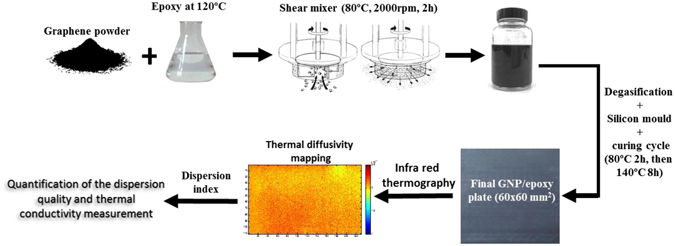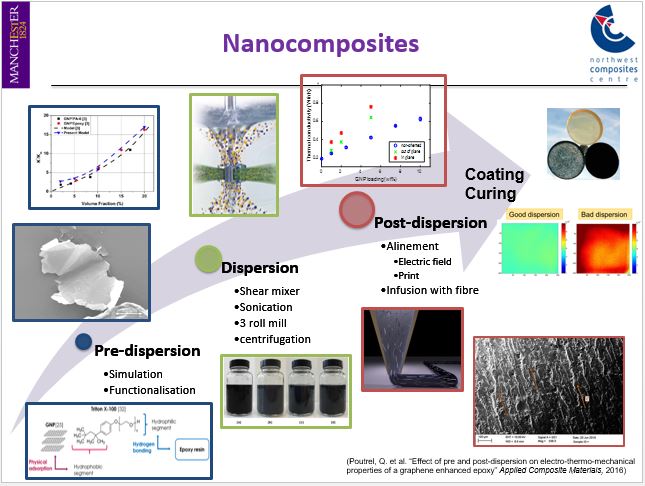Introduction
Graphene nanoplatelet (GNP) modified epoxy nanocomposites are becoming attractive to aerospace due to possible improvements in their mechanical, electrical and thermal properties at no weight cost. The process of obtaining reliable material systems provides many challenges, especially at larger scale (a volume effect). This paper reports on the main fabrication stages of GNP-based epoxy composites, namely (i) pre-dispersion, (ii) dispersion, and (iii) post-dispersion. Each stage is developed to show the interest and potential it delivers for property enhancement. Chemical modification of GNP is presented; functionalisation by Triton X-100 shows elastic modulus improvements of the epoxy at low particle content (≤3%). The post-dispersion step as an alignment of GNP into the epoxy by an electrical field is discussed. The electrical conductivity is below the simulated percolation threshold and an improvement of the thermal diffusivity of 220% when compared to non-oriented GNP epoxy sample is achieved. The work demonstrates how the addition of functionalised graphene platelets to an epoxy resin will allow it to act as electrical and thermal conductor rather than as insulator.
Thermal Diffusivity Mapping of Graphene Based Polymer Nanocomposites
Nanoparticle dispersion is widely recognised as a challenge in polymer nanocomposites fabrication. The dispersion quality can affect the physical and thermomechanical properties of the material system. Qualitative transmission electronic microscopy, often cumbersome, remains as the ‘gold standard’ for dispersion characterisation. However, quantifying dispersion at macroscopic level remains a difficult task. This paper presents a quantitative dispersion characterisation method using non-contact infrared thermography mapping that measures the thermal diffusivity (α) of the graphene nanocomposite and relates α to a dispersion index. The main advantage of the proposed method is its ability to evaluate dispersion over a large area at reduced effort and cost, in addition to measuring the thermal properties of the system. The actual resolution of this thermal mapping reaches 200 µm per pixel giving an accurate picture of graphene nanoplatelets (GNP) dispersion. The post-dispersion treatment shows an improvement in directional thermal conductivity of the composite of up to 400% increase at 5 wt% of GNP. The Maxwell-Garnet effective medium approximation is proposed to estimate thermal conductivity that compare favourably to measured data. The development of a broadly applicable dispersion quantification method will provide a better understanding of reinforcement mechanisms and effect on performance of large scale composite structures.


